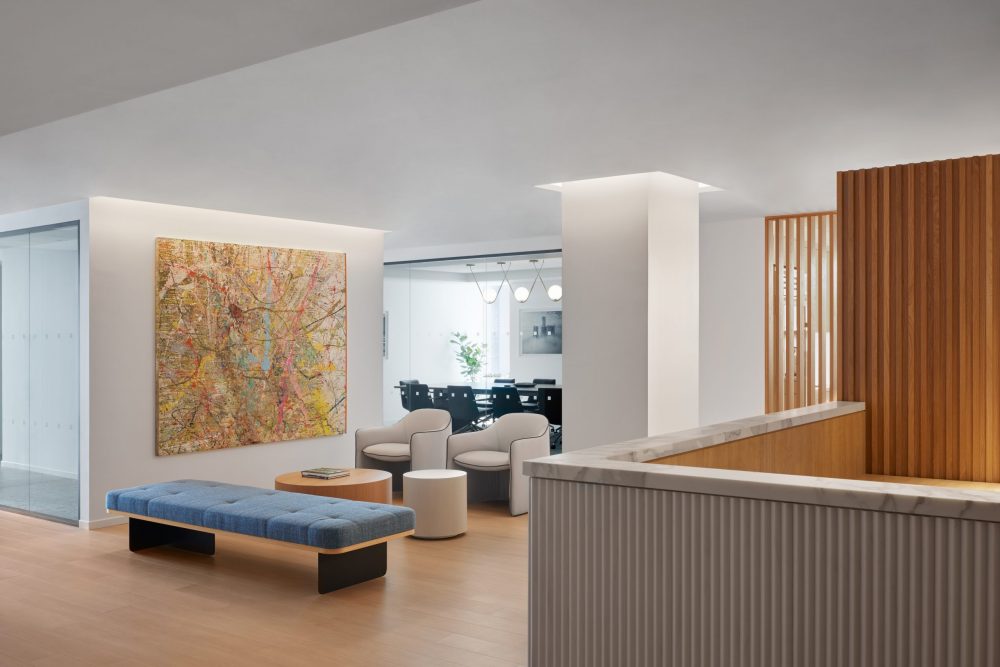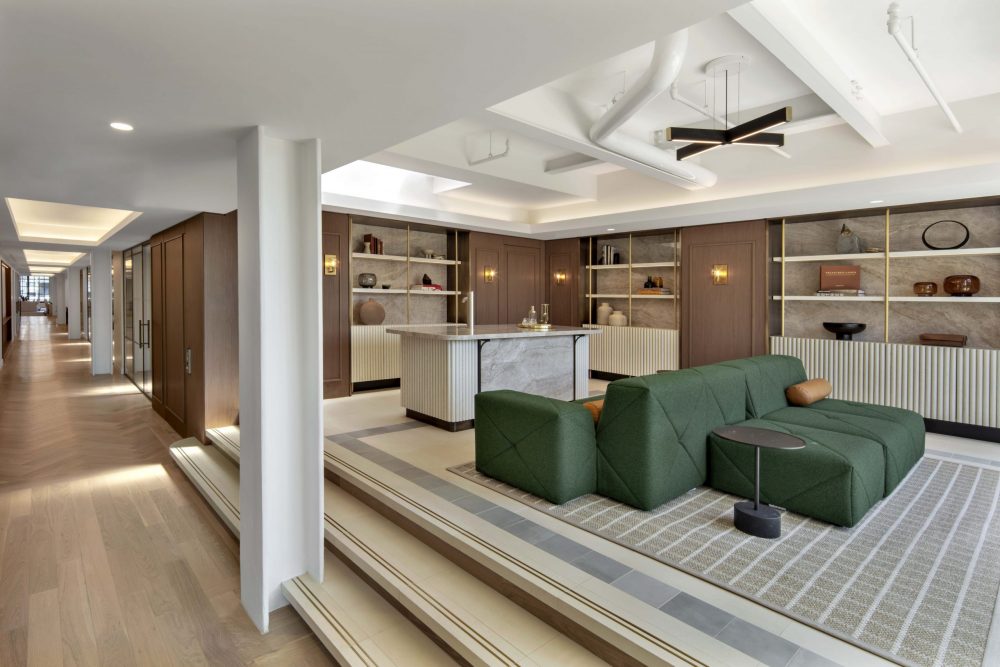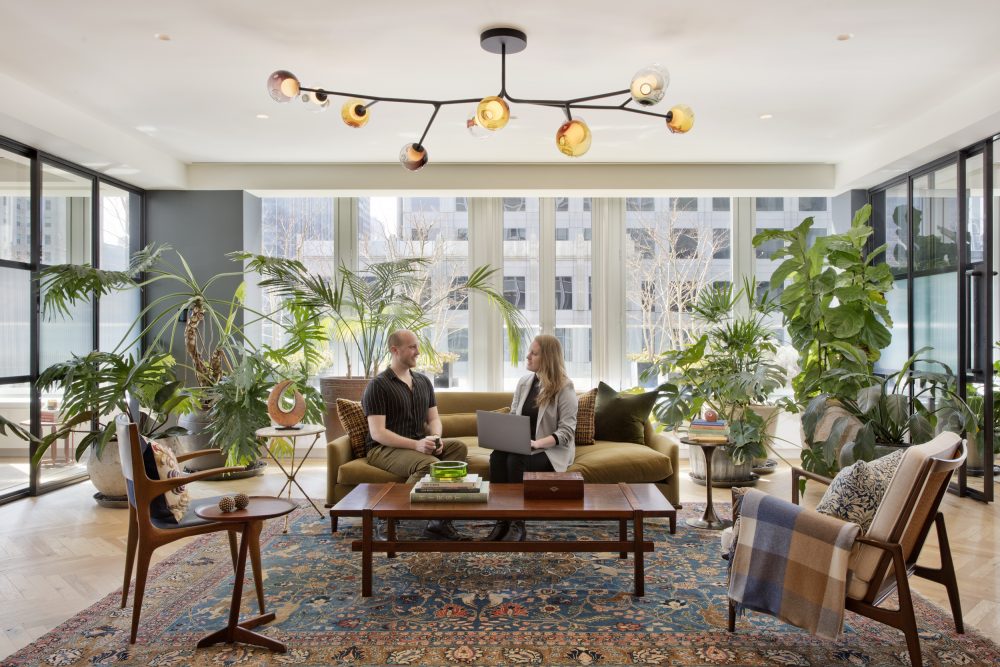Spectorgroup‘s Design Director, Steven South, explains how the workplace is learning from industries like travel and hospitality to make the office a destination.
Today’s workplace faces a critical challenge: creating an office that people actively want to return to. For many companies, early efforts centered on ‘resimercial’ design—an approach that blended the comforts of home with a professional environment to ease the transition back to in-person work. Yet, as companies grapple with low occupancy and evolving expectations around flexibility, it’s clear that simply mirroring home’s comforts isn’t enough.
To re-engage teams, the office needs to offer something distinct: a compelling destination that takes cues from the world of hospitality to usher in a new, travel-inspired workplace environment. Imagine walking into a space where warm, inviting lounges replace rows of desks, immersive breakout zones encourage creativity, and thoughtfully designed areas support both focused work and social connection. From coffee bars with café-style seating to wellness zones filled with natural light and cozy nooks, every corner is crafted to refresh and re-energize. In this new vision, the office is more than a workspace; it’s a memorable, energizing destination that provides an appealing break from the home environment.
The Destination Office
Today’s travel landscape is dominated by the allure of experience, and we’ve seen a marked increase in the amount of discretionary income spent on travel. People no longer want their office to mirror their living space—they want a destination that draws them in and offers something they might not be able to find elsewhere.
This can take many forms, the first of which involves a focus on art curation. Incorporating art pieces and contributions from local artisans gives a workplace a sense of personality and curated individuality, reflecting the location’s regional identity. For a project we’re currently working on in Omaha, we’ve enlisted local artists to include landscape murals throughout the space to tie the office’s identity back to the area in which it exists.

The careful selection of decor over mass-produced items also enhances the destination-like feel. This elevated approach to decor selection helps to tell the story of the space alongside the integration of art and sculpture, transforming the office into a visually exciting, museum-quality space that teams look forward to working in.
Key Design Elements
A few other key elements put the hospitality-influence of today’s workplace on full display: upscale amenity centers and hospitality-inspired lounges. These amenities can include barista bars, expansive private dining rooms, luxurious lounges and even terraces with scenic views. Our work on the Kimmeridge Energy Management headquarters in New York City features a stunning terrace with views overlooking the Hudson and a hospitality-focused bar designed to host a broad range of gatherings.

This thoughtful design carries over to meeting and general event spaces, which are now envisioned as hospitality venues—complete with antique and vintage furnishings, catering setups, and support for internal and external events. These spaces also often function through a reservation system, allowing for the flexible use of different space typologies, almost exactly like those guests encounter at hospitality spaces when traveling for business. Providing a coworking-like experience adds an air of novelty that keeps the workday feeling fresh and exciting for teams while accommodating fluctuating levels of occupancy.
Operational Excellence and Hospitality-Level Service
Another area in which the world of hospitality excels involves back-of-house operations and service. Backstage service design, which typically includes the thoughtful implementation of circulation and support areas for service staff, is now included in commercial spaces to support programming, akin to features you’d find at a high-end hotel.
At one confidential client’s Manhattan office, an entire support staff is tasked with setting up and maintaining conferencing and event spaces to enhance the experience for staff and visitors. We integrated pantries and setup areas to make the barista’s job easier, ultimately creating a more effortless, enjoyable experience for employees and guests alike.
Curated elements in hospitality spaces often extend to sensory aspects, and we’re experimenting with their use in office environments. At the same confidential client’s office, we tested a range of scents to give the space a unique feel, finally settling on one from Jo Malone that we felt mirrored the space’s design and energy to create a more holistic experience.

The Future of Dynamic Workplaces
With the zeitgeist shifting to favor spaces that offer more than just comfortable chairs and residential styling, the future of the commercial workplace rests in creating a destination for team members with distinctive offerings and elements they’re unable to get from environments outside of work.
As companies embrace this new paradigm, the focus will shift toward designing environments that engage the senses and foster community. These spaces will promote collaboration and creativity and allow individuals to explore and discover, recalling the excitement of travel adventures. The integration of local art, upscale amenities, and thoughtful service will redefine the workplace, making it a dynamic destination that reflects its location’s cultural and geographical identity.
This shift represents what employees value most today—experiences that enrich their lives, enhance their workdays and provide a compelling reason to return to the office.


